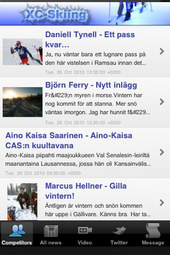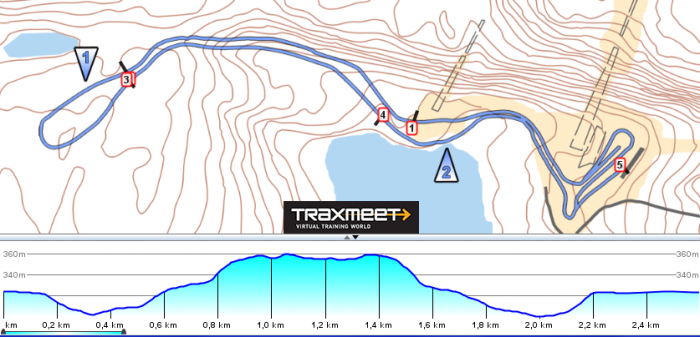
The pursuit races over 15 km and 10 km in Kuusamo last weekends were the first Cross Country Skiing World Cup races featuring online GPS tracking. This gives a lot of interesting data which may be used to analyze the race development.
For an introduction to the concept, see this story at fiscrosscountry.com. The replay of the GPS-data may be viewed here for men and here for women. The Kuusamo 2.5 km loop is shown above. The men’s 15 km had 6 loops in the 2.5 km course, the women’s 10 km had 4 loops. For the analysis below, 5 split times are defined – marked 1 – 5. The segments are chosen in order to investigate how the skiers perform in different types of terrain; segment 1-2 is uphill, 2-3 and 4-1 (4-5 on the last loop) are flat and 3-4 is downhill.
Note! This article looks into the types of analysis it is possible to do with the GPS-data. No full analysis is made – rather possibilites are investigated. It is possible to do this kind of analysis live during the race – there is in principle no data available now after the race compared to what was available during the race (except for the 30-40 second delay in receiving GPS data in the web-client). This type of live analysis would give added value both for viewers and for TV commentators. The usefulness of this kind of analysis is of course even bigger in an interval start than in a mass start/pursuit start.
Men’s 15 km: Northug versus Cologna
The big fight of the day was the fight for victory in the men’s 15 km pursuit – Petter Northug starting 12 seconds ahead of Dario Cologna. The illustration below shows the fight between the two based on the GPS-data. Along x-axis you see the distance (from start to the left to finish to the right) with the race profile below showing the uphills and downhills. The red line is a real-time comparison between Cologna and Northug (dashed line is were the GPS-signal is out). When the red line is below the horizontal black line, Cologna is behind Northug – when the red line is above the horizontal black line, Cologna is ahead. The maximum spacing between the skiers is 13 seconds shown with a dashed black line. From the illustration you can see how Cologna catches Northug on the first loop, taking half of the time in the first uphill between 0.5 km and 1.0 km and the rest in the flat area around 2.3 km (Northug gives up here). The most interesting thing in this illustration is how Cologna tries to get away in each uphill, and gets a few seconds (the red peaks around 3.5, 5.9, 10.8 and 13.2 km). Notice however how Northug uses the short flatter area in the middle of the uphill to gain some time on Cologna. Notice also how fast Northug gets back to Cologna at the top of the hill. This is especially evident in the 5th loop. Northug knows that he is strong enough to catch Cologna on the flat parts – and can therefore save some power in the uphills.

Men’s 15 km: Legkov versus Northug/Cologna
The other interesting situation in the race was if Legkov (starting 42 seconds behind Northug) would catch up with the leading duo. To look into how Legkov raced compared to Northug, we use a different type of illustration where we let both start together. The illustration shows how Legkov gains time on Northug in every uphill until 6 km (in addition to the flat area where Northug lets Cologna catch him)- gaining a total of 18 seconds – but then it is over for Legkov (see also the corresponding real-time comparison here).

Men’s 15 km: Fight for best time of the day – Poltoranin versus Rønning
While Northug and Cologna were fighting for victory in the front – to some degree playing cat and mouse – the fight for the best time of the day (and a World Cup victory) was further behind between Poltoranin and Rønning. A comparison between the tow skiers is shown below – again using real time data. The illustration shows how Poltoranin started 10 seconds behind Rønning, and caught him at around 6 km. Nearly all of the time is gained in the uphills (long uphill 2.3 km, short uphill around 4.7 km and long uphill 5.6 km). Poltoranin is ahead of Rønning for a while between 8 and 10 km, but is behind in the rest of the race. This was enough to win the race of the day.

Men’s 15 km: Breakdown of the day – Vylegzhanin
Vylegzhanin had impressive speed for a long time – skiing together with Poltoranin for the first 5.5 km, and then speeding away in the long uphill towards 6 km (see illustration below). However, Vylegzhanin lost steam around 7 km (end of downhill / flat area – did he fall down?), and lost all energy after this incident. In the end Vylegzhanin was 48 seconds behind.

Comparing Vylegzhanin’s race with Northug’s (this time assuming they started together – i.e. not real time), one can see how Vylegzhanin gains time on Northug in every single uphill until the incident around 7 km – and quite a lot of time actually (41 seconds at the top of the hill around 6 km).

Uphill stars: Where the race is decided
The GPS data makes it possible to do detailed analysis of how much time the skiers gain/loose in different type of terrain. As described in the star of the article, the course has been divided into four sections which are categorized as either flat, uphill or downhill. Unfortunately GPS-data is missing for some skiers in some parts of the course, so e.g. Poltoranin and Cologna could not be included in this analysis. However, there is still plenty of interesting data.
The below table sums the time for uphill, flat and downhill for each skier. You can also see the time uphill/downhill for each skier. Summing all the uphill regions for the skiers considered, Vylegzhanin is clearly the best – 9 seconds ahead of Rønning, 10 seconds ahead of Olsson/Manificat and 12 second ahead of Halfvarsson. This is even if Vylegzhanin looses 10 seconds in his down period in the4th loop. Vylegzhanin’s times for the uphill parts are 2:04, 2:11, 2:13, 2:27, 2:18 and 2:20 (fastest in all except for the 4th). Rønning has 2:07, 2:15, 2:18, 2:22, 2:25 and 2:22.
Compared to the best splits, Northug looses 30 seconds in the uphills, 30 seconds in the flat and only 3 seconds in the downhill. Northug is second fastest in the downhill parts – only Sedov is faster – Sedov being the fastest in 5 of 6 downhills and Belov being the one consistently loosing most time downhill. Note also how Northug consistently is among the fastest in the flat part from split 2 to split 3 – after the long uphill. Thus Northug loosing time in the uphill to Cologna is not because he is tired, but it is part of the tactical play in order to save energy.
When looking at this data, note that there is a lot of tactics in a handicap start – so everything isn’t necessarily as it might seem at first sight.
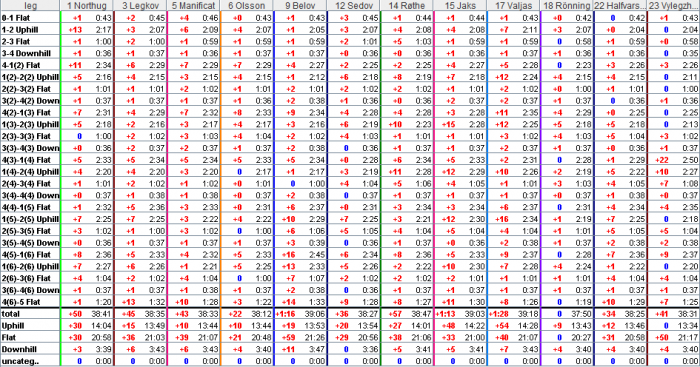
Women’s 10 km
There was a lot less excitement in the women’s class – and also only 10 skiers with GPS receivers. Thus, only a limited analysis is presented for the women.
First we take a look at Johaug versus Bjørgen where we let both start together. As you can see from the illustration, Johaug gains time in each uphill – especially at the end of the long uphill in the last loop. Note however that Bjørgen had already won the race here, so you can not learn much from the comparison.

Taking a look at Kowalczyk versus Bjørgen (again simulated starting together), you see that Kowalczyk gains time in the first part of the course (but rather in the flat parts than in the uphill parts) – but then looses time in the second half. It may look like Kowalczyk has given up here based on the GPS-data.

Lastly, we present a similar uphill/downhill/flat table for the women (note that the last split is missing for Kowalczyk – the second last is obviously wrong). As expected, Johaug is strongest in the uphills. Bjørgen is fastest in the flat regions whereas Skofterud is fastest fownhill. None of the women really loose time downhill except for Randall.
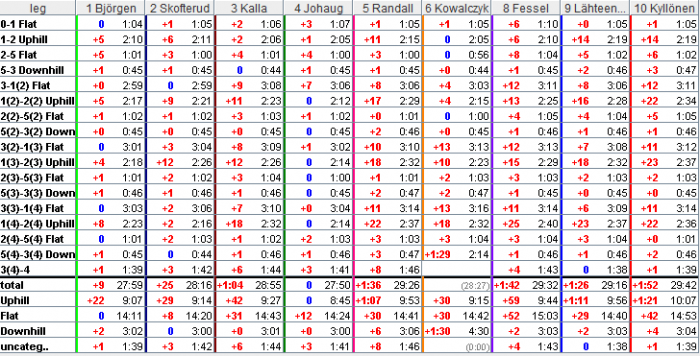
Conclusions
There is a lot of interesting analysis to be made based on this kind of GPS-data – and with the appropriate tools (they are almost there already, actually) this kind of analysis could be done live and give a lot of added value both for viewers and for TV commentators. The usefulness of this kind of analysis is of course even bigger for interval start races – I really hope that FIS continues with this kind of GPS coverage after this initial success – and that it is extended also to interval start races.
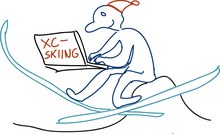 This weekend the Cross Country skiing World Cup visits Düsseldorf for an individual sprint on Saturday and a team sprint on Sunday. Remember to set up your predictions ahead of the Düsseldorf sprint on Saturday!
This weekend the Cross Country skiing World Cup visits Düsseldorf for an individual sprint on Saturday and a team sprint on Sunday. Remember to set up your predictions ahead of the Düsseldorf sprint on Saturday!










